How To Draw A Giraffe Pattern
With its graceful walk and gangly, long cervix, giraffes can be catchy to describe accurately. But with these tips and a pace-by-stride drawing tutorial, y'all can bring your giraffe sketches to life.
How drawing giraffes tin stretch your skills.
Equally the world's tallest living terrestrial beast, giraffes are iconic. These herbivores wander the grasslands in small groups, searching for greens and evading predators. While the life of a giraffe may seem relatively elementary, that'due south not the case when it comes to sketching them. With their exaggerated proportions, "giraffes are fascinating animals, merely they're adequately complex to draw," says illustrator Terryl Whitlatch.
Before y'all sketch a giraffe, practise some enquiry. "It'southward e'er helpful to study the skeletal structures and the defining shapes that the animal is fabricated of," notes illustrator and art director Alex Braun. When you understand how their ears are shaped, how their knees bend, and the gradient of their spine, you lot're better equipped to draw a svelte, center-catching giraffe.
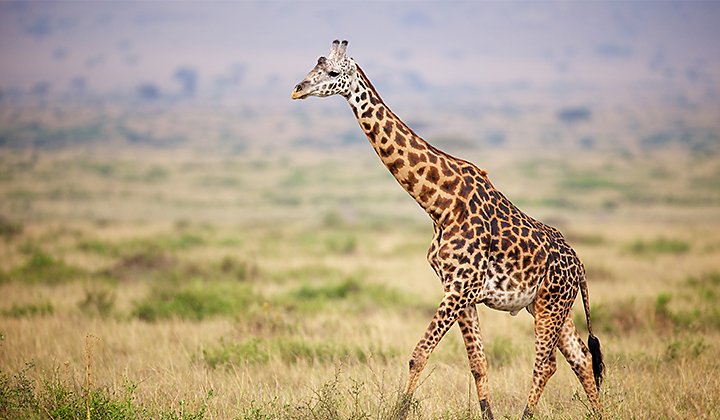
Start with these simple steps.
i. Plan your drawing.
When it comes to reference photos, retrieve "there are several different subspecies of giraffe, and each one has its own special spot design," says Whitlatch. For example, the pattern on the Rothschild's giraffe is quite different from the marks on the Masai giraffe. If you want to draw a cute drawing giraffe, these details are less of import. But if you lot desire to create a realistic drawing, the details are of import.
2. Break down the bones shapes.
Before y'all get to the details, you lot need to sketch a bones underdrawing to get the lines of your giraffe shape correct. "I always just simplify the body into bones shapes," explains Whitlatch "Be methodical and notice how sloped the back is, for instance. Or how its front legs are somewhat longer and taller than its hind legs." Use circles and oval shapes to block in the major parts of the giraffe. See where the joints connect, and notice the thickness of the giraffe'southward cervix. If you lot analyze these simple shapes, you're more probable to become an accurate creature cartoon.
3. Polish the shapes and silhouette.
"Once y'all've got that overall structure down, you can refine the drawing," says Witchlatch. Perfect those curved lines and define the muscles. Remember, while they tin look alpine and spindly, giraffes are actually big, sturdy mammals. Help your drawing communicate that density by adding some calorie-free shading to show shadow and dimension.
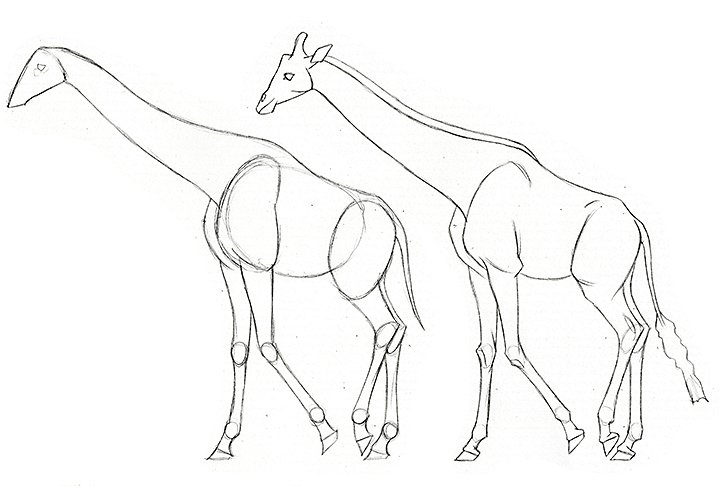
4. Depict the spots.
Just like a cheetah, giraffes accept distinctive spots. Outline the spots and depict them so they wrap around the giraffe's trunk. This will help give your cartoon more dimension. Check your reference photos as yous go, and be certain to modify and adjust the size and shape of the spots. "The design starts to fade equally you move down the giraffe's leg, and the spots get smaller and smaller until they almost disappear," says Braun. If you're working digitally, put the spots on a new layer and so you can color and edit them separately from the remainder of the giraffe.
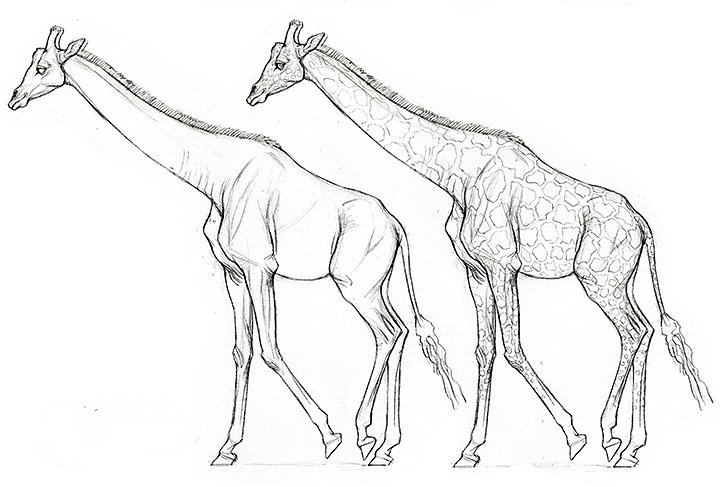
5. Add a base of operations color.
Utilize light yellowish or beige to color the base of your giraffe'due south glaze. If you're working digitally, use clipping masks and soft brushes to achieve gentle gradients that don't spill into the background of the cartoon. Go along your light source in mind and add lighter colors in areas of highlight.
6. Color in the spots.
Requite your giraffe its iconic print past coloring in the spots with a night reddish brownish. With the spots on a split layer in your digital cartoon, you can use clipping masks to add gradients to the markings, while leaving the rest of your drawing untouched. Continue in listen that some giraffes have fewer or lighter spots on their face.
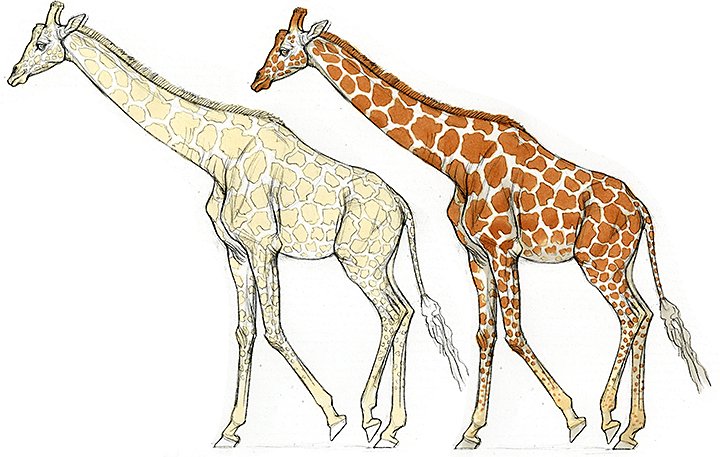
seven. Give it some particular.
With the majority of the colors added, go in and add together details to the giraffe's head, mane, tail, and hooves. "Utilise soft brushes to create separate gradients and shade the mouth, the top of the head, and the horns," says Braun. On top of that layer, you tin can describe in the oral fissure, optics, and snout.
8. Shade the drawing.
"I always like to change the shading color to give information technology a little more than life. I try to stay abroad from grays or blacks, just because it can make animals expect kind of boring and makes the colors less vibrant," explains Braun. "I also employ a very soft brush to highlight the giraffe'southward face up to prove where light is coming from." Use those soft brushes and washes to create definition in the head, neck, and hip joints. With merely some uncomplicated shading you can transform a apartment sketch into a lifelike drawing.
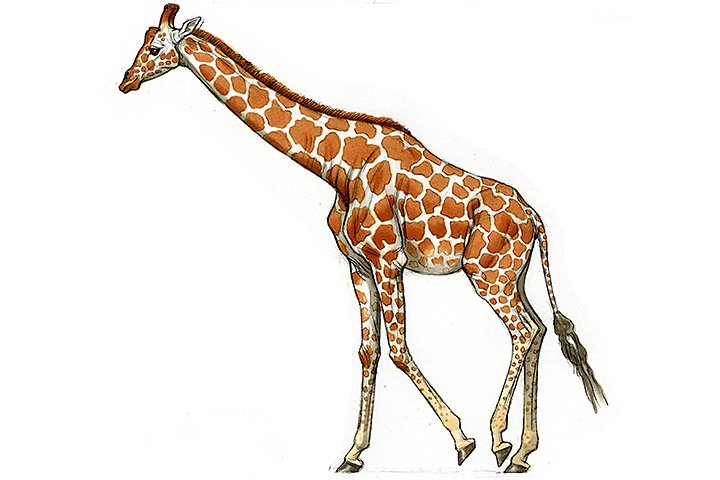
Notice inspiration in other artists.
Take a wait at giraffes that talented artists are creating on Behance.
- Go an upwards shut and personal view with this realistic giraffe portrait made using Adobe Fresco.
- Have a different approach and sketch your own cartoon character, like this cute giraffe riding a moped scooter.
- Draw inspiration from children'southward books like this artist did, and brand a simplified, brightly colored giraffe.
- After visiting a local zoo, this creative person created a stylized illustration of a giraffe face.
Perfect your drawings digitally.
Take your giraffe drawings to another level and accomplish merely the look you're going for with Fresco. Explore live brushes that work like existent watercolors or oil paints and vector brushes that can scale to any size. Apply multiple layers to keep the spots separate from the body of your giraffe, and apply gentle gradients without smudging your outlines or altering your groundwork.
Source: https://www.adobe.com/sea/creativecloud/illustration/discover/how-to-draw-a-giraffe.html
Posted by: khangwartan.blogspot.com


0 Response to "How To Draw A Giraffe Pattern"
Post a Comment